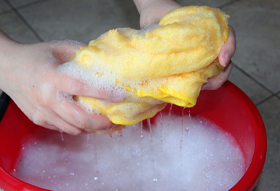
How to Clean Foam Like a Pro!

Cleanliness is always a concern, particularly with longer life products such as foam that is used in a variety of settings and uses. During the winter months when illnesses are more common, antibacterial cleaning is also a worry. This is in addition to the cleaning of items in order to remove physical, visible dirt from the surface and from within.
Due to its versatile nature, foam is frequently used in high contact point areas such as in sofas, children’s play centres, crash mats and foam pits. In areas where foam is directly exposed – i.e. without a cover, such as in foam pits and often in children’s play centres – the cleaning of foam components themselves is even more vital. However, it is worth remembering that many types of polyurethane foam are naturally impervious to bacteria.
To clean upholstery foam, water is obviously the key element. However, some extra precautions must be taken when caring for your foam. For example, it is important to avoid submerging memory foams in water as due to their dense nature, these foams will take a considerable amount of time to dry out. When cleaning any type of foam material, we therefore recommend the use of a reuseable spray bottle in which your cleaning agent can be mixed with water (if needing to be diluted).
Two popular items used in the foam cleaning are rubbing alcohol and white vinegar, in addition to a microfibre cloth. Before cleaning with a solution, it is important to wipe down the foam material with a microfibre cloth to ensure the removal of any debris, including food crumbs, strands of hair and other small particles. It is best to start by tackling stubborn stains using the rubbing alcohol. To do so, dip your cloth directly into the rubbing alcohol and wipe the affected area.

For the generic cleaning of a foam piece, find an all-purpose cleaner that does not include bleach. Before cleaning the whole piece, patch test the solution on a smaller area to ensure that it does not damage or discolour the foam. Using a spray bottle, apply your cleaner to the material and use a rag-like cloth to wipe over, but ensure to conduct this with a one-direction wipe rather than a scrubbing action. Incorrect methods could rub dirt further in and aggravate stains. Once complete, apply more rubbing alcohol or white vinegar solution to heavily blemished areas.
To rinse the material without submerging it in water, use a liquid detergent that is heavily diluted with water. Submerge a second clean cloth into the water and use the soapy solution to rinse out the remaining chemicals used to clean the stubborn areas. Next, move on to the wider foam object, ensuring that it is cleaned as fully as possible. To ensure a full antibacterial clean, finish by spraying the foam with a non-toxic antibacterial fabric spray.
In many cases, professional cleaning of foam may not be necessary. By following these simple steps, all are able to successfully clean different types of foam by using high-street products. Circumstances are of course different for foam components used in hospitals and other clinical care settings (these need to be fully sterilised), but most items are suitable for home cleaning. As the leading UK supplier of foam, eFoam encourages all customers to contact us should they have any queries relating to cleaning practises.

